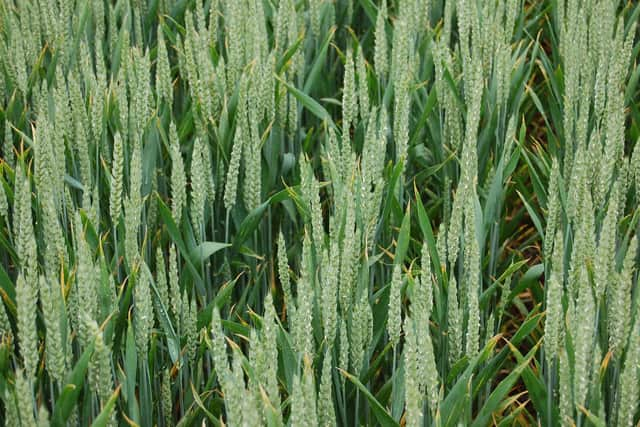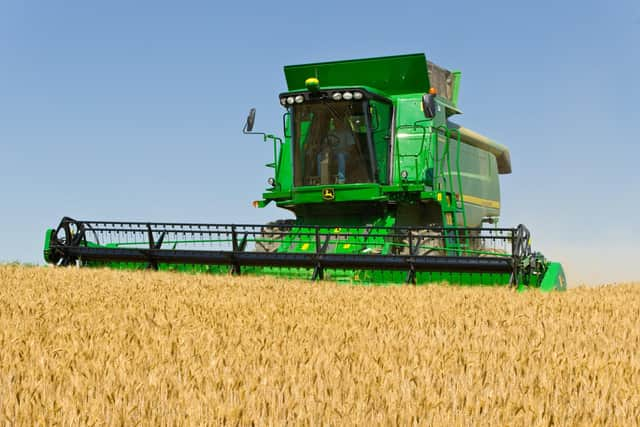Determining the accurate carbon footprint of arable cropping systems
and live on Freeview channel 276
This is an issue that has been addressed directly by Teagasc’s Head of Environment, Crops and Land Use Programme, John Spink.
He has indicated that the out-workings of the most recent carbon footprint calculations should not come as a total shock.
Advertisement
Advertisement
Spink cited the fact that Irish grain yields are amongst the highest in the world.


Meanwhile, Irish farmers make very efficient use of applied nitrogen, one of the most important contributors to overall output.
So how are the carbon footprint values of a cropping enterprise actually calculated?
John Spink explained: “There are two carbon accounting methods and people will often get confused between them.
Advertisement
Advertisement
“They have different system boundaries. So different criteria are included within them.”


He continued: “The first one is the IPCC model.
“This represents the Inter-Governmental Panel on Climate Change approach.
“This is used for the purposes of the national inventory. The second option is the Life Cycle Assessment or LCA model.
“This is used to calculate the actual carbon footprint of a product.
Advertisement
Advertisement
“The values here are worked through on the basis of per unit of output. This can relate to grain, milk and meat.”
According to Spink, activity data are required for the operation of both models.
Where cropping systems are concerned, these criteria include, the actual tillage systems employed, the amount of fertiliser used and the actual forms in which this was applied.
He continued: “Specifically, where LCA is concerned the final yield of the crop must also be included.
Advertisement
Advertisement
“This allows for the emissions produced per hectare to be divided across the overall output of the crops being assessed.”
Emission factors must also be included in all carbon footprint calculations.
The basic level is a Tier I default value. However, it is also possible to calculate more precise carbon value footprints by using Tier 2 or Tier 3 values.
John Spink again: “The use of more precise emissions factors also requires the availability of more detailed activity-related data.
Advertisement
Advertisement
Underpinning all of this is research work carried out by the likes of Teagasc which can accurately link projected greenhouse gas emission levels, post the application of specific crop inputs.
One of the most important of these is the emission factor linking the application of nitrogen fertiliser to the subsequent production of nitrous oxide gas.
John Spink further explained: “In the case of calcium ammonium nitrate, or CAN, applied under Irish conditions, we know that 0.35% of the nitrogen applied.”
He added: “In total contrast, the international default figure currently stands at 1.0% of the nitrogen applied.
Advertisement
Advertisement
“So Irish emissions from CAN are about one third whey they would be in other parts of the world.
However, fertiliser is only one source of nitrogen emissions within a tillage system. The decomposition of crop residues and the nitrogen in applied organic materials must also be factored-in.
“We don’t have local emission factor values for these specific sources of greenhouse gas emission.
“So we have to use international figures,” Spink further explained.
Advertisement
Advertisement
Spink confirmed that further research will be undertaken by Teagasc to developed bespoke Irish emission factors, linking both the application of animal manures and crop residue decomposition to subsequent greenhouse gas production levels.
He added: “Most people suspect that the final figures calculated for Ireland, in this regard, will be substantially lower that the international values that are currently available.”
Significantly, the latest carbon footprint values for Ireland’s tillage sector also include the sequestration impact of active straw incorporation.
“This is assuming a straw yield of 4t/ha,” said Spink.
“On light soils this equates to just under one tonne of carbon being sequestered.
Advertisement
Advertisement
“At the other end of the spectrum, clay soils will sequester twice this amount of carbon.
“We have included these figures into the overall carbon footprint calculations.”
He continued: “We have also included five years of data, generated on the back of rotation-based crop trials.
“The figures have been generated form plough-based calculations.
Advertisement
Advertisement
“These indicate that continuous winter wheat has a slightly higher carbon footprint value than the other cropping options.
“This is because the amounts of applied nitrogen are slightly higher. Continuous wheat crops are also slightly lower yielding.”
According to Spink, the carbon embedded in applied fertiliser is accounting for almost half the carbon dioxide emissions produced within a cropping regime.
“Emissions created when the fertiliser is actually applied to the soil must also be accounted for,” he explained.
Advertisement
Advertisement
“This accounts for 24% of the carbon dioxide that is produced.
“So, approximately three-quarters of the greenhouse gas emissions with winter wheat production are linked directly and indirectly, with the application of nitrogen fertiliser.
“Fuel use accounts for 14% of total greenhouse gas production Crop residues currently come in at 10%.
“However, this figure may well decrease once we get bespoke crop residue emission factors that relate to Irish conditions.
Advertisement
Advertisement
“Seed accounts for 3.0% of the carbon footprint generated by a tillage system with crop protection accounting for a further 1.0%.”
John Spink concluded: “Net emissions take account of the gross emissions generated by a crop.
“If we take away the amount of carbon sequestered by incorporated straw, this generates a nett emissions’ value.
“And in the case of winter oats, this is getting us very close to a zero value, where overall emissions from the crop are concerned.”
The role of new technologies within cropping systems
Advertisement
Advertisement
Meanwhile, there is a growing expectation that the adoption of new technologies will help arable farmers reduce, still further, the carbon footprint of their businesses.
A case in point is Syngenta’s recent confirmation of its commitment to the development of plant biostimulants.
Driving this technology has been the identification of bespoke bacteria (endophytes) with the ability to fix nitrogen from the atmosphere.
The principles being played out are similar to those demonstrated by rhizobium bacteria in the roots of legumes: clover, beans, peas etc.
Advertisement
Advertisement
What makes endophytes specifically of interest is the fact that they can fix atmospheric nitrogen, irrespective of where they reside within a cereal plant, grass or legume.
Endophytes are non-pathogenic bacteria that spend a part of their life cycle within a plant host. This is achieved through a colonisation process.
Those with the ability to fix nitrogen can do so while residing in the leaves and roots.
Also of significance in this regard is the rhizosphere.
This is the region of the soil that is directly influenced by root secretions and associated soil microorganisms.
Advertisement
Advertisement
Endophytes have a symbiotic relationship with the host crop. They receive energy from the plant in the form of sugars while, in return, converting atmospheric nitrogen to the ammonium cation (NH4+).
It’s a process that misses out the formation of ammonia gas with the inherent potential for gaseous losses to the atmosphere.
In addition, the ammonium cation can be easily converted to the nitrate anion (NO3-), the chemical form of nitrogen that is most easily assimilated by all plants.
Nitrogen has long been recognised as a key plant nutrient. It is a key driver of both overall crop yield and quality.
Advertisement
Advertisement
Most soils contain up to 75t of organic nitrogen, the vast bulk of which is totally unavailable to the plant.
It was only at the beginning of the 20th century that two German scientists, Haber and Bosch worked out how to convert atmospheric nitrogen to ammonia.
This opened up the opportunity to develop bespoke nitrogen fertilisers for use in production agriculture. The rest is history.
However, the key drawback with Haber-Bosch process is the vast quantities of energy required to drive the chemical reactions taking place.
Advertisement
Advertisement
Recent years have also seen a growing awareness of the environmental challenges that can arise when nitrogen fertilisers are used to excess.
Ammonia significantly deteriorates air quality standards while nitrate leaching can significantly impact on water quality.
Interest in nitrogen fixing endophytes has been stimulated by their ability to fix atmospheric nitrogen in ways that make all the resulting nutrient available to the crop.
As a consequence, there is absolutely no escape of nitrogen to the atmosphere or into surrounding water courses.
Advertisement
Advertisement
The end result is a win: win scenario for production agriculture...in theory.
Biostimulant crop trials
Syngenta is confirming the successful conclusion of trials, held to evaluate the impact of its crop biostimulant: Vixeran®
The product can be used to boost crop yields, when accompanying a recommended nitrogen fertiliser application regime with cereals.
Alternatively, it will deliver savings of between 30 and 50kg of applied nitrogen per hectare when used to maintain an average yield targets in both feed wheat and barley crops.
Advertisement
Advertisement
Vixeran® is not being recommended for use on malting barley crops at the present time
Syngenta field technical manager, Andy Cunningham, spoke at a technical briefing earlier this week.
He confirmed that Vixeran® can boost feed wheat and barley yields by 0.3t/ha when used in tandem with a full fertiliser nitrogen regime.
He added: “It is applied as a foliar spray between growth stages 21 and 31.
“The application rate is 50g/ha.
Advertisement
Advertisement
“Vixeran® is fully compatible with many other tank mix constituents that are applied to crops at this stage in their development, including plant growth regulators.”
The active ingredient within the biostimulant is a bacterium called: Azobacter salinestris.
Once added to a crop, it multiplies across the leaves and the roots, supporting plants throughout the entire season.
According to Syngenta, Vixeran® can be successfully applied to beans: it acts to complement the nitrogen fixing capacity of the legume late in the growing season.
Advertisement
Advertisement
Nitrogen fixing nodules are normally formed within bean plants three to five weeks post emergence.
These start to fix nitrogen as soon as they are formed.
However, around the time of pod filling the nodules will gradually senesce and therefore stop fixing nitrogen.
Given that pulses are a great source protein, the demand for nitrogen is highest exactly when the nodules have senesced off. This means the plant preferentially robs the required nitrogen from leaves.
This saps the plant of its photosynthetic yield building potential.
Advertisement
Advertisement
However, by supplementing the nitrogen-need with Vixeran® it reduces the burden on the leaves.
This allows the plant to carry on photosynthesising and so increasing yield.
Trials, carried out in 2023, have confirmed that the application of Vixeran® can boost bean yield by up to 0.53t/ha.
Syngenta is also claiming that the biostimulant can boost grass silage yields significantly.
Trials points to a 10% increase in yield across first and second silages.
In addition, silages made from Vixeran®-treated grass can be safely fed to ruminant livestock.